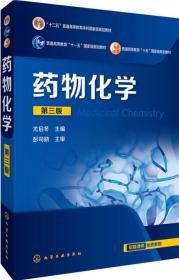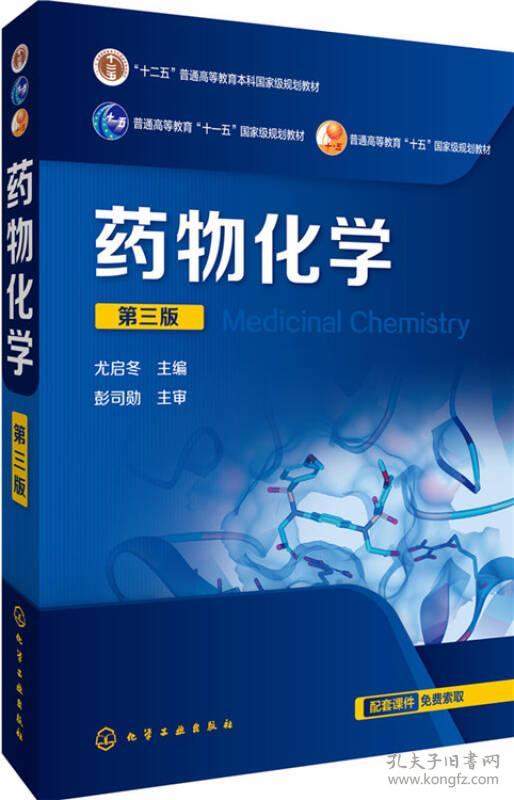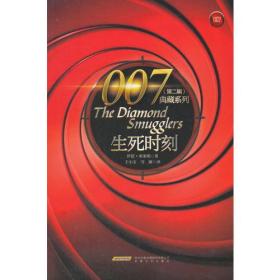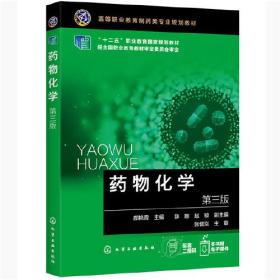
药物化学(第三版)
¥ 18.16 3.3折 ¥ 55 九品
仅1件
北京东城
认证卖家担保交易快速发货售后保障
作者尤启冬 编
出版社化学工业出版社
出版时间2015-11
版次3
装帧平装
货号A1
上书时间2024-11-06
- 最新上架
商品详情
- 品相描述:九品
图书标准信息
- 作者 尤启冬 编
- 出版社 化学工业出版社
- 出版时间 2015-11
- 版次 3
- ISBN 9787122248503
- 定价 55.00元
- 装帧 平装
- 开本 16开
- 纸张 胶版纸
- 页数 543页
- 字数 99999千字
- 正文语种 简体中文
- 【内容简介】
-
《药物化学》是教育部普通高等教育“十五”、“十一五”国家级规划教材和“十二五”普通高等教育本科国家级规划教材。
《药物化学》(第三版)删除了第二版中相对比较陈旧的内容,增加一些现代药物化学的新知识点,尤其是近年来新的学科知识,同时对原有的章节进行适当的调整,不仅保留了药物化学课程中各类药物的具体内容,更重要的是,通过前四章内容系统介绍了药物的化学结构所反映的理化性质、结构特征、药物代谢特点与药物活性的关系,即近年来学术界和产业界公认的“构性关系”、“构效关系”和“构代关系”,这是药物的化学本质,也是药物化学的核心所在。
《药物化学》(第三版)以新药研究与开发为主线,结合新药设计、发现和发展过程,介绍新药研究中所使用的方法、原理;介绍各类药物的结构类型、理化性质、构效关系、变化规律以及主要合成路线;并将经典的药物设计方法、QSAR研究与计算机辅助药物设计结合在一起讲解。
《药物化学》(第三版)可供药学类各专业、制药工程专业本科生作为专业课教材使用,也可供相关科研人员学习参考。
- 【作者简介】
-
尤启冬,中国药科大学药学院,院长,博导,1982年毕业于南京药学院(中国药科大学的前身)并获理学学士学位,1985年于中国药科大学获药物化学专业理学硕士学位,1989于上海医药工业研究院获药物化学专业博士学位。1994年赴英国Strathclyde大学药学系从事博士后研究。现任中国药科大学药学院院长,中国药学会理事,中国药学会药物化学专业委员会副主任委员;江苏省药学会副秘书长等学术职务。是国家精品课程《药物化学》和国家双语示范课程《药物化学》的课程负责人、国家教学团队负责人、教育部实验教学中心药学学科组组长。《药学进展》副主编、《中国药物化学》等9本杂志的常务编委、编委等职。
- 【目录】
-
绪论(Introduction)/ 1
一、药物化学的研究内容和任务(the Scopes and Purpose of Medicinal Chemistry)1
二、药物化学的研究和发展(Research and Development of Medicinal Chemistry)2
三、我国药物化学的发展(Achievements of PRC in Medicinal Chemistry)5
四、新药研究与开发的过程和方法(Process and Methods of New Drug Research and Development)6
选读文献9
第一章药物结构与生物活性(Structure-Activity Relationships of Drugs)/ 10
第一节药物理化性质对药物活性的影响(Affection of Physical and Chemical Properties of Drugs on Pharmacologic Activity)11
一、药物结构与理化性质(Chemical Structure and Physico-Chemical Properties of Drugs)11
二、药物的亲脂性和药物活性(Lipophilic Properties and Pharmacological Activities of Drugs)12
三、药物的pKa和药物活性(pKa and Pharmacological Activities of Drugs)13
四、药物溶解度与药物活性(Solubility and Pharmacological Activities of Drugs)14
五、药物结构与药物透膜性(Chemical Structure and Permeability of Drugs)17
第二节药物的结构对药物活性的影响(Affection of Drug Structure on Pharmacological Activities)18
一、药物与受体的键合作用(Binding of Drugs on Receptor)19
二、药物的各官能团对药效的影响(Affection of Functional Groups of Drugs on Pharmacological Activities)20
三、药物电荷分布对药效的影响(Affection of Charge Distribution of Drugs on Pharmacological Activities)22
四、药物的立体异构体对药效的影响(Affection of Stereoisomers of Drugs on Pharmacological Activities)22
第三节药物结构对药物转运的影响(Affection of Drug Structure on Transportation)25
一、药物化学结构对膜转运的影响(Affection of Drug Structure on Membrane Transportation)25
二、药物化学结构对血脑屏障透过性的影响(Affection of Drug Structure on Blood-Brain Barrier Penetration)27
第四节药物结构对药物毒副作用的影响(Affection of Drug Structure on Side Effects and Toxicities)28
一、药物对细胞色素P450的作用(Action of Drugs on Cytochrome P450)28
二、药物对心脏快速延迟整流钾离子通道(hERG)的影响(Affection of Drugs on hERG)29
选读文献32
第二章药物结构与代谢(Structure-Metabolics Relationships of Drugs)/ 33
第一节官能团化反应(Functionalization Reactions)33
一、氧化反应(Oxidation)34
二、还原反应(Reduction)42
三、水解反应(Hydrolysis)42
第二节结合反应(Conjugation Reactions)43
一、葡萄糖醛酸结合(Glucuronic Acid Conjugation)44
二、硫酸结合(Sulfate Conjugation)45
三、氨基酸结合(Conjugation with Amino Acids)46
四、谷胱甘肽或巯基尿酸结合(Glutathione or Mercapturic Acid Conjugation)47
五、乙酰化结合(Acetylation)49
六、甲基化结合(Methylation)50
第三节药物代谢研究在药物开发中的应用(Application of Drug Metabolism Research in Drug Development)51
选读文献54
第三章药物设计的基本原理和方法(Basic Principles of Drug Design)/ 55
第一节先导化合物发现的方法和途径(Approaches for Lead Discovery)55
一、从天然产物活性成分中发现先导化合物 (From Bioactive Component of Natural Resources)56
二、通过从分子生物学途径发现先导化合物 (From Molecular Biology Research)58
三、通过随机机遇发现先导化合物(From Accidental Discovery)59
四、从代谢产物中发现先导化合物(From Metabolites)60
五、通过从临床药物的副作用或者老药新用途中发现新药(From Side-Effect or New Purpose of Medicine)60
六、从药物合成的中间体中发现先导化合物(From Synthetic Intermediates)61
七、通过计算机辅助药物筛选寻找先导化合物(By Screening of Compound Databases)62
八、通过其他的方法得到先导化合物(Other Methods)63
第二节先导化合物的优化(Lead Optimization)64
一、烷基链或环的结构改造(Alterations of Compound with Alkyl or Ring)64
二、生物电子等排(Bioisosteres)66
三、前药原理 (Prodrug Principle)70
四、软药(Soft Drug)74
五、硬药(Hard Drug)74
六、孪药(Twin Drug)75
第三节定量构效关系(Quantitative Structure-Activity Relationships)76
一、疏水性参数(Lipophilicity Parameters)77
二、电性参数(Electronic Parameters)78
三、立体参数(Steric Parameters)78
四、Hansch方法在药物设计中的应用(Hansch Method Using on Drug Design)78
第四节计算机辅助药物设计(Computer-Aided Drug Design)80
一、基于受体结构的药物设计(Receptor-Structure-Based Drug Design)80
二、基于小分子的药物设计(Molecular-Based Drug Design)82
选读文献85
第四章镇静催眠药和抗癫痫药(Sedative-Hypnotics and Antiepileptics)/ 86
第一节镇静催眠药(Sedative-Hypnotics)86
一、镇静催眠药的发展及分类(Development and Classification of Sedative-Hypnotics)86
二、镇静催眠药的作用靶标及作用机制(Target and Mechanism of Action)87
三、苯二氮类催眠镇静药(Sedative-Hypnotics of Benzodiazepines)89
四、非苯二氮类GABAA受体激动剂(Nonbenzodiazepine GABAA Agonists)96
五、褪黑素受体激动剂(Melatonin Receptor Agonists)98
第二节抗癫痫药(Antiepileptics)99
一、巴比妥类药物(Barbiturates)100
二、巴比妥类的同型药物(Homotypical Drugs of Barbiturates)103
三、二苯并氮杂类(Dibenzoazepines)105
四、GABA类似物 (Analogues of GABA)106
五、脂肪羧酸类 (Carboxylic Acids)107
六、其他结构类药物(Other Drugs)107
选读文献108
第五章精神神经疾病治疗药(Psychoterapeutic Drug)/ 109
第一节经典的抗精神病药(Classical Antipsychotic Drugs)109
一、吩噻嗪类(Phenothiazines)109
二、硫杂蒽类(Thioxanthenes)115
三、丁酰苯类及其类似物(Butyrophenones and Analogues)117
四、苯甲酰胺类(Benzamides)119
五、二苯二氮类及其衍生物(Dibenzodiazepines and Derivatives)120
第二节非经典的抗精神病药物(Atypical Antipsychotic Drugs)121
一、非经典的抗精神病药物的作用机制(The Mechanism of Atypical antipsychotic drugs)121
二、非经典的抗精神病药物(Atypical Antipsychotic Drugs)122
第三节抗抑郁药(Antidepressive Drugs)125
一、单胺氧化酶抑制剂(Monoamine Oxidase Inhibitors,MAOIs)126
二、去甲肾上腺素重摄取抑制剂(Norepinephrine Reuptake Inhibitors)127
三、选择性5-羟色胺重摄取抑制剂(Selective Serotonin Reuptake Inhibitors)130
四、新发展的抗抑郁药(New Antidepressant Drugs)133
第四节抗焦虑药和抗躁狂药(Antianxiety Drugs and Antimanic Drugs)136
一、抗焦虑药(Antianxiety Drugs)136
二、抗躁狂药(Antimanic Drugs)137
选读文献137
第六章神经退行性疾病治疗药物(Drug for Neurodegeneration Disease)/ 138
第一节抗帕金森病药(Anti-Parkinson’s Disease Drugs)138
一、抗帕金森病药物的作用机制(Action Mechanism of Anti-Parkinson’s Disease Drugs)138
二、作用于多巴胺能神经系统的药物(Agents on Dopaminergic Neural System)139
三、NMDA受体拮抗剂(NMDA Receptor Antagonists)144
四、腺苷A2A受体抑制剂(Adenosine A2A Receptor Inhibitors)144
五、作用于其他靶点的药物(Agents on Other Targets)145
第二节抗阿尔茨海默病药物(Anti-Alzheimer’s Disease Drugs)147
一、胆碱能系统改善药物(Drugs of Improving Cholinergic System)148
二、β、γ-分泌酶抑制剂(β、γ-Secretase Inhibitors)152
三、Tau蛋白抑制剂(Tau Protein Inhibitors)154
四、H3受体拮抗剂(H3 Receptor Antagonists)155
五、NMDA受体拮抗剂(NMDA Receptor Antagonists)156
六、抗氧化药物(Antioxidation Drugs)156
选读文献157
第七章镇痛药(Analgesics)/ 158
第一节吗啡及其衍生物(Morphine and Its Derivatives)158
第二节合成镇痛药(Synthetic Analgesics)161
一、吗啡烃类及苯并吗喃类(Morphinane and Benzomorphane)161
二、哌啶类(Piperidines)163
三、氨基酮类(Aminoketones)165
四、其他类(Others)167
第三节阿片受体和阿片样物质(Opiate Receptors and Opiate-Like Substances)167
一、阿片受体及其晶体结构(Opiate Receptors and Their Crystal Structures)167
二、阿片样物质(Opiate-Like Substances,OLS)168
选读文献170
点击展开
点击收起
相关推荐
— 没有更多了 —
















以下为对购买帮助不大的评价